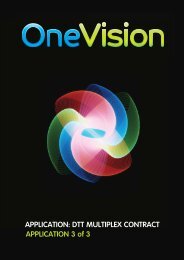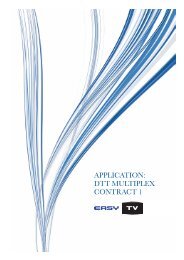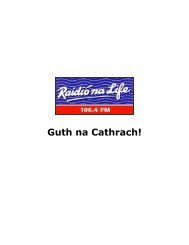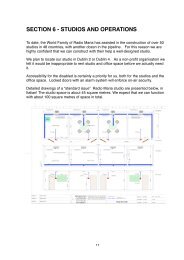Digital Radio for Ireland: Competing Options, Public Expectations - BCI
Digital Radio for Ireland: Competing Options, Public Expectations - BCI
Digital Radio for Ireland: Competing Options, Public Expectations - BCI
Create successful ePaper yourself
Turn your PDF publications into a flip-book with our unique Google optimized e-Paper software.
standard digital radio system <strong>for</strong> short‐wave, medium‐wave and long‐wave ‐ digital radio <strong>for</strong> the radio <br />
frequencies below 30MHz – and offers near‐FM sound quality and has the capacity to integrate text <br />
and data with potentially large coverage areas. Countries such as India and Russia have adopted DRM <br />
as the best technology <strong>for</strong> converting their vast broadcasting networks to digital. In 2008, the BBC and <br />
Deutsche Welle (DW) launched a new <strong>Digital</strong> <strong>Radio</strong> Mondiale radio channel <strong>for</strong> Europe with 18 hours <br />
daily of international programmes in English from BBC World Service and DW. The service is available <br />
across much of Western Europe and the signal covers France, Germany, Belgium, Netherlands, <br />
Luxembourg and other neighbouring countries. An extension to the standard, DRM+, offers an <br />
equivalent strategy <strong>for</strong> digitalisation in the VHF bands. <br />
In the United States, the proprietary HD <strong>Digital</strong> <strong>Radio</strong> system allows existing AM and FM radio stations <br />
to transmit both analogue and digital signals on the same frequency allowing an upgrade path <strong>for</strong> <br />
listeners. It enables AM and FM radio stations to simulcast both digital and analogue audio within the <br />
same channel as well as add new FM channels and text in<strong>for</strong>mation. <br />
In almost every market and region, however, the progress of digital radio has been slower than <br />
anticipated, characterised by limited consumer awareness and uneven support by broadcasters. <br />
Switch‐off of analogue transmission networks and replacement by digital systems remains a distant <br />
prospect though road maps <strong>for</strong> a digital transition have been established in major markets such as <br />
France and the United Kingdom. In France, a timetable has been established which will require all new <br />
radio receivers – including in‐car and mobile phones receiver ‐ to be digital‐enabled by 2013. 14 In the <br />
United Kingdom, the government has set 2015 as the target date by which Britain’s national radio <br />
stations, and most local stations, will stop broadcasting on analogue and move to <strong>Digital</strong> Audio <br />
Broadcasting. The UK’s <strong>Digital</strong> Britain report commits the government to a policy ‘enabling DAB to be <br />
a primary distribution network <strong>for</strong> radio’ and creates a plan <strong>for</strong> a digital switchover ‘when 50% of radio <br />
listening is digital and when national DAB coverage is comparable to FM coverage, and local DAB <br />
reaches 90 per cent of population and all major roads’. 15 Yet, uncertainty remains and the disparaging <br />
newspaper headline that DAB may turn out to be the ‘Betamax’ of radio, 16 allied to the high profile <br />
withdrawal of Channel 4’s offering, or the sale of the commercial multiplex in the United Kingdom, <br />
links digital radio uncom<strong>for</strong>tably with previous failed technology implementations such as AM stereo <br />
in radio’s past. Somewhat ominously, a Deloitte report on the outlook <strong>for</strong> DAB in the U.K. – still the <br />
most important market <strong>for</strong> digital radio – casts doubt on the governement’s ambition <strong>for</strong> a digital <br />
transition by 2015 and states that ‘the enduring appeal of analogue radio, combined with the growing <br />
power of internet radio, may ultimately lead many consumers to sidestep DAB technology <br />
altogether’. 17 <br />
<strong>Digital</strong> radio, however, now means more than just the replacement of analogue broadcasting with a <br />
digital equivalent. In practical terms, radio now exists as a multiplat<strong>for</strong>m medium with analogue, <br />
digital, satellite and the internet being the most important. With the rise of the internet, the wide <br />
penetration of broadband technologies and rapid expansion of mobile communications technologies, <br />
<br />
14 ‘French <strong>Radio</strong> Sets All <strong>Digital</strong> by 2013’. <strong>Radio</strong> World. URL: <br />
http://www.radioworld.com/printableView.aspx?contentid=76464 <br />
15<br />
<strong>Digital</strong> Britain: The Interim Report. 2009 Department <strong>for</strong> Culture, Media and Sport. URL: <br />
http://www.culture.gov.uk/what_we_do/broadcasting/5944.aspx <br />
16<br />
Plunkett, J. (2008). Is DAB radio the next Betamax? The Guardian. Tuesday January 29 2008. <br />
17 Deloitte UK, ‘<strong>Digital</strong> Audio Broadcasting (DAB) radios ‐ the <strong>Digital</strong> Index’. URL: <br />
http://www.deloitte.com/dtt/article/0,1002,cid%253D205019,00.html <br />
13






